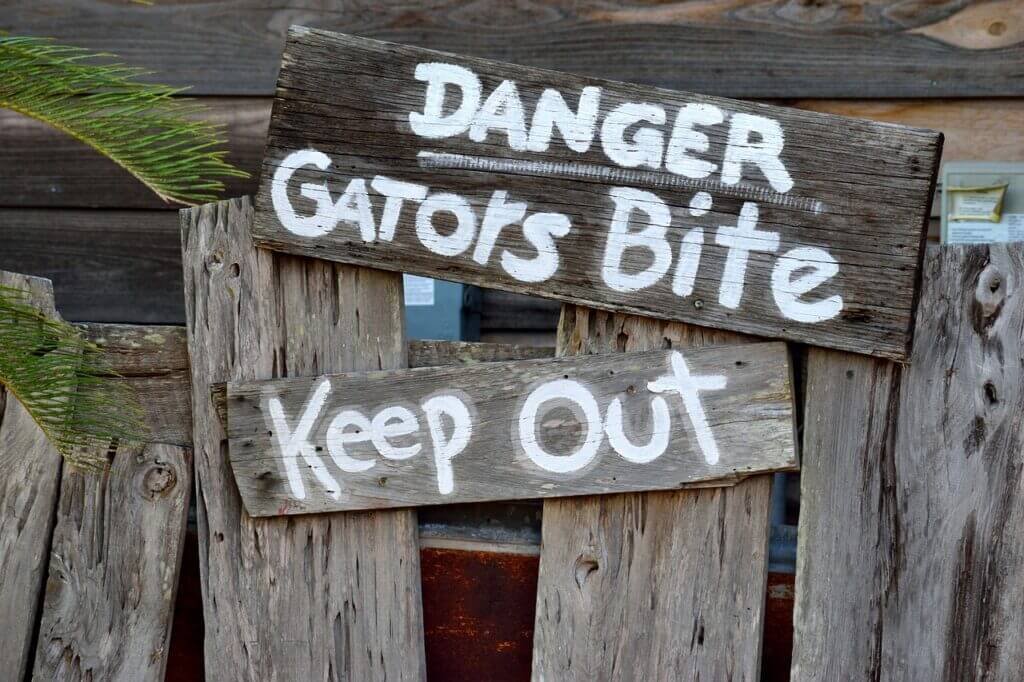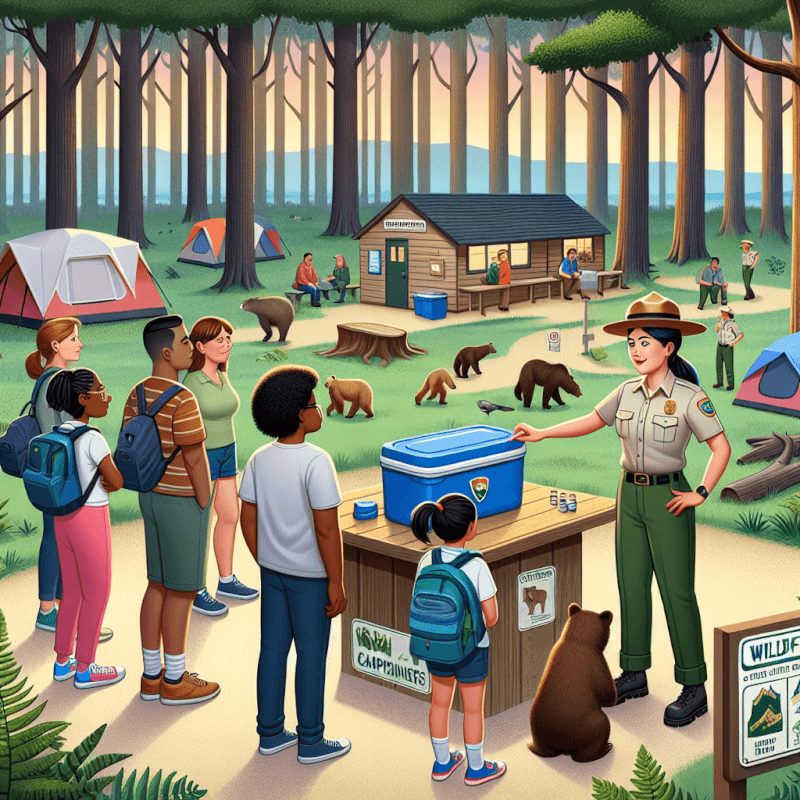So you’re planning a camping trip and you want to make sure you’re prepared for any unexpected encounters with wildlife? Look no further! In this article, we’ll explore some essential tips and tricks to help you prevent and handle wildlife encounters at campgrounds, ensuring a safe and enjoyable experience for you and your fellow campers. From proper food storage techniques to understanding animal behavior, we’ve got you covered. So let’s dive in and get ready to embark on a thrilling and wildlife-friendly camping adventure!
Understanding Wildlife Behavior
When it comes to preventing and handling wildlife encounters at campgrounds, it is essential to have a good understanding of wildlife behavior. By knowing the common wildlife species in your area and learning about their behavior and habitats, you can better anticipate and avoid potential encounters. Different animals have different needs and behaviors, so familiarize yourself with the wildlife that may be present in your camping location.
Identifying common wildlife species
Start by identifying the common wildlife species in your area. It can be helpful to research and learn about the typical animals found in the region where you are camping. This knowledge will enable you to recognize the signs of their presence and identify them if you come across any wildlife during your camping trip.
Learning about their behavior and habitats
Once you can identify the wildlife species in your area, take the time to learn about their behavior and habitats. Understanding their natural tendencies and preferences will help you predict their behavior and avoid potential encounters. For example, some animals are more active during certain times of the day or year, while others have specific food preferences or nesting habits. By understanding these aspects, you can adjust your behavior and camping practices accordingly.
Understanding the reasons behind wildlife encounters
It’s also crucial to understand the reasons behind wildlife encounters. Animals are often attracted to campgrounds by the presence of food or easily accessible resources. By understanding what attracts wildlife, you can take steps to minimize these attractants and reduce the chances of encountering wildlife during your camping trip.
Preventing Wildlife Encounters
Preventing wildlife encounters is the first line of defense in ensuring a safe and enjoyable camping experience. By taking proactive measures, you can significantly reduce the likelihood of encountering wildlife. Here are some essential steps to consider:
Choosing a suitable campsite
Selecting a suitable campsite can make a significant difference in preventing wildlife encounters. Look for campsites that are away from natural attractants such as water sources, food storage areas, or animal trails. Additionally, consider the surrounding vegetation and terrain, as some animals may be more likely to frequent certain environments.

Proper food storage and waste disposal
One of the main reasons wildlife is attracted to campsites is the availability of food and waste. Proper food storage and waste disposal are crucial to minimize these attractants. Use bear-resistant containers to store your food, and never leave food unattended or exposed. Dispose of waste properly in designated containers or bury it at least 200 feet from your campsite.
Minimizing attractants
In addition to properly storing food and waste, there are other steps you can take to minimize attractants. Avoid cooking or eating in your tent, as the smell of food can attract wildlife. Keep your cooking area clean and make sure to wash dishes and utensils thoroughly. It’s also a good idea to clean up any spilled food or leftovers promptly.
Keeping a clean and tidy campsite
Lastly, keeping a clean and tidy campsite is essential in preventing wildlife encounters. Remove any food scraps, trash, or leftovers from your campsite. Dispose of them properly in designated containers or by packing them out. Regularly clean your camping gear, tents, and cooking equipment to remove any lingering odors that may attract wildlife.
Safety Measures During Wildlife Encounters
Despite our best efforts to prevent wildlife encounters, there may still be situations where we come face-to-face with wild animals. In these instances, it’s crucial to stay calm, take appropriate safety measures, and understand defensive behaviors. Here are some safety measures to keep in mind:
Remaining calm and avoiding sudden movements
When encountering wildlife, the first thing to remember is to stay calm and avoid any sudden movements. Sudden movements can startle or provoke the animal, potentially leading to an aggressive response. Instead, maintain a calm demeanor, and try to slowly back away from the animal without turning your back to it.
Maintaining a safe distance
Keeping a safe distance from wildlife is essential for both your safety and the animal’s well-being. Different animals have different comfort zones and personal spaces, so it’s important to respect their boundaries. Use binoculars or a camera with a zoom lens to observe and appreciate wildlife from a safe distance. Avoid approaching wildlife, even if they seem friendly or docile.

Using bear spray or deterrent devices
In certain situations, using bear spray or deterrent devices can be an effective means of protecting yourself during a wildlife encounter. Bear spray is a specially formulated pepper spray designed to deter bears and other aggressive animals. Familiarize yourself with its proper use and carry it with you when venturing into areas with a higher risk of wildlife encounters.
Understanding defensive behaviors
It’s essential to understand the defensive behaviors of different wildlife species. Some animals, like bears, may exhibit defensive behaviors when they feel threatened. These behaviors can include vocalizations, snorting, stomping, or charging. By recognizing these signs, you can take appropriate action to de-escalate the situation and give the animal the space it needs.
Dealing with Specific Wildlife Encounters
While it’s impossible to cover every possible wildlife encounter in this article, let’s briefly discuss how to handle encounters with some of the most common wild animals you might encounter while camping.
Encountering bears
If you encounter a bear, it’s important to remain calm and avoid direct eye contact. Back away slowly, making yourself as non-threatening as possible. Do not run, as this may trigger a chase response. If the bear approaches, try to make yourself appear larger by raising your arms or opening your jacket. If the bear attacks, use bear spray or any other deterrent you may have.
Encountering cougars
When encountering a cougar, maintain eye contact and make yourself appear larger by raising your arms. Speak loudly and firmly, and if possible, throw objects at the cougar to distract it. Back away slowly, giving the cougar an escape route. If the cougar approaches, make yourself look as big as possible and use bear spray or other deterrent devices.
Encountering wolves
If you come across a wolf, avoid running or turning away. Stand your ground and maintain eye contact. Make yourself appear large by raising your arms and speaking assertively. If the wolf continues to approach, use bear spray or other deterrent devices. It’s important to note that wolf encounters are rare, and most wolves are shy and avoid human contact.

Encountering snakes
Snakes are generally more afraid of humans than we are of them. If you encounter a snake, give it plenty of space and avoid disturbing it. Do not attempt to handle or move the snake, as this can provoke it. If the snake is in a location where it poses a risk, contact local authorities or wildlife experts for professional assistance in handling the situation.
Encountering coyotes
Coyotes are generally wary of humans but can become more aggressive in certain circumstances. If you encounter a coyote, do not run or turn your back. Make yourself look larger by raising your arms or opening your jacket. Make loud noises and throw objects towards the coyote to deter it. If the coyote continues to approach, back away slowly and leave the area.
Encountering raccoons
Raccoons are known for their scavenging behavior and may be attracted to campsites due to the presence of food and waste. To avoid raccoon encounters, follow proper food storage and waste disposal practices as mentioned earlier. If you do encounter a raccoon, make loud noises, clap your hands, and try to scare it away. Never attempt to feed or approach raccoons, as they can become aggressive when falsely conditioned to human food.
Educating Yourself and Fellow Campers
Education plays a vital role in preventing and handling wildlife encounters. By educating yourself and fellow campers about local wildlife and best practices, you can create a safer camping environment for everyone. Here are some ways to educate yourself and others:
Researching local wildlife and campgrounds
Before your camping trip, take the time to research the local wildlife and the campgrounds you will be visiting. Familiarize yourself with any specific rules or regulations regarding wildlife encounters in the area. Understand the best practices for camping in that particular region and share that information with your fellow campers.
Attending educational programs or workshops
Many campgrounds or local organizations offer educational programs or workshops on wildlife safety and behavior. Take advantage of these opportunities to learn from experts and gain valuable knowledge and skills. Attend seminars, presentations, or guided hikes that focus on wildlife safety and responsible camping practices.

Sharing knowledge and tips with fellow campers
Once you have acquired knowledge and information about wildlife safety, be sure to share it with your fellow campers. Encourage open discussions about wildlife encounters and best practices. By sharing experiences, tips, and concerns, you can contribute to a collective understanding of wildlife behavior and foster a safer camping community.
Emergency Response
While prevention is key, it’s essential to be prepared for emergencies when dealing with wildlife encounters. Here are some critical aspects to consider for emergency response:
Knowing the emergency numbers
Before embarking on your camping trip, familiarize yourself with the emergency contact numbers in the area. Program them into your phone or have them readily available in case of an emergency. This will ensure a prompt response if you need to report a wildlife encounter or seek assistance.
Basic first aid skills
Having basic first aid skills is invaluable when dealing with wildlife encounters or any other camping-related emergencies. Take a first aid course before your camping trip to learn essential skills such as treating wounds, managing allergies, or performing CPR. Carry a well-stocked first aid kit with you and make sure it is easily accessible at all times.
Evacuation procedures
In some situations, evacuation may be necessary to ensure your safety during a wildlife encounter or other emergency. Familiarize yourself with the campground’s evacuation procedures and any designated safe areas or shelters. Have a plan in place, and make sure everyone in your camping party knows how to proceed in the event of an evacuation.
Interacting Responsibly with Wildlife
Responsible interaction with wildlife is essential for their preservation and our safety. By following these guidelines, you can ensure that you are respectful of the animals’ space and natural behaviors:

Avoiding feeding or approaching wildlife
Feeding wildlife is not only harmful to their health but also disrupts their natural feeding habits and can lead to an increased likelihood of dangerous encounters. Never attempt to feed or approach wildlife, regardless of how docile or friendly they may appear. Respect their autonomy and allow them to forage for their natural diet.
Respecting their space and natural behaviors
Wildlife needs space and privacy to survive and thrive. Respect their natural behaviors and avoid disturbing or intruding on their territory. Keep a safe distance and observe animals from afar using binoculars or a camera with a zoom lens. Do not try to touch, chase, or otherwise interact with the animals.
Reporting wildlife sightings and incidents
If you witness any wildlife sightings, particularly if they involve unusual behaviors or pose a risk to public safety, report them to local authorities or park rangers. This information can assist in monitoring and managing wildlife populations and identifying potential problem areas or individuals.
Children and Wildlife Safety
When camping with children, their safety around wildlife should be a top priority. Here are some important considerations for ensuring children’s safety:
Supervising children at all times
Children should be supervised closely when in wildlife areas or campgrounds. Ensure that they remain within sight and earshot at all times. Teach them to respect wildlife and understand the importance of not approaching or disturbing animals.
Teaching children about wildlife safety
Educate children about wildlife safety from an early age. Teach them to recognize and respect wildlife from a distance, and explain the potential dangers of approaching or interacting with animals. Encourage them to ask questions and foster a sense of curiosity and respect for the natural world.
Establishing safety rules for children
Establishing safety rules for children is crucial when it comes to wildlife encounters. Clearly communicate these rules to your children and enforce them consistently. For example, instruct them to stay away from wild animals, never feed them, and alert an adult if they spot any potentially dangerous wildlife.
Equipment and Tools for Wildlife Safety
Having the right equipment and tools can greatly enhance your safety and peace of mind when camping in wildlife areas. Consider the following:
Carrying bear-resistant containers
Bear-resistant containers are specially designed to prevent bears and other wildlife from accessing your food. Investing in bear-resistant containers and using them to store your food can significantly reduce the risk of attracting wildlife to your campsite.
Using bear-resistant coolers
Similar to bear-resistant containers, bear-resistant coolers are designed to keep food secure and inaccessible to wildlife. These coolers are made with sturdy locks and construction to deter animals from accessing the contents. Using a bear-resistant cooler can help keep your food safe and prevent wildlife encounters.
Installing electric fencing
In some situations, installing electric fencing can provide an extra layer of protection against wildlife encounters. Electric fencing can be useful for creating a barrier around your campsite or food storage area to deter larger animals. It’s important to follow local regulations and obtain the necessary permits, if required, before installing electric fencing.
Packaging food and waste properly
Properly packaging your food and waste is essential to prevent wildlife encounters. Use sealed containers or bags to store your food, eliminating any odors that could attract animals. Seal waste in secure containers and dispose of it properly to avoid attracting wildlife to your campsite.
Additional Tips and Recommendations
Here are some additional tips and recommendations to further enhance your safety and minimize wildlife encounters:
Keeping pets under control
If you are camping with pets, it’s important to keep them under control at all times. Pets can provoke wildlife or become targets themselves, leading to potential conflicts or dangerous situations. Follow leash laws, keep pets within your immediate vicinity, and never allow them to approach or chase wildlife.
Using noise and light to deter wildlife
Some wildlife, such as raccoons or coyotes, can be deterred by loud noises or bright lights. Use noise-making devices, such as air horns or whistles, to scare away animals that may be approaching your campsite. Additionally, use bright lights or lanterns to create a deterrent effect at night.
Checking for wildlife activity before setting up camp
Before setting up camp, scout the area for signs of recent wildlife activity. Look for tracks, droppings, or other signs of wildlife presence. Choose a campsite that shows minimal indicators of animal activity to minimize the chances of encountering wildlife.
Staying informed about wildlife-related regulations and guidelines
Regulations and guidelines regarding wildlife encounters may vary depending on the location and camping area. Stay informed about the specific regulations in the area you plan to camp in. Follow any guidelines provided by local authorities or park rangers to ensure your safety and the well-being of the wildlife in the area.
In conclusion, preventing and handling wildlife encounters at campgrounds requires a combination of knowledge, preparation, and responsible behavior. By understanding wildlife behavior, taking preventative measures, and knowing how to respond in various situations, you can enjoy a safe and memorable camping experience while respecting and protecting the diverse wildlife populations around you. Remember, wildlife encounters are an opportunity to appreciate and learn from nature, so always approach them with respect and caution.


